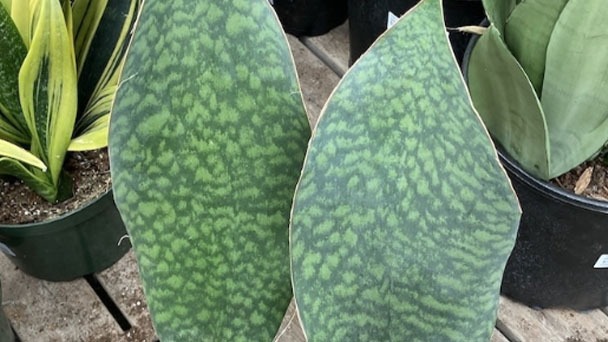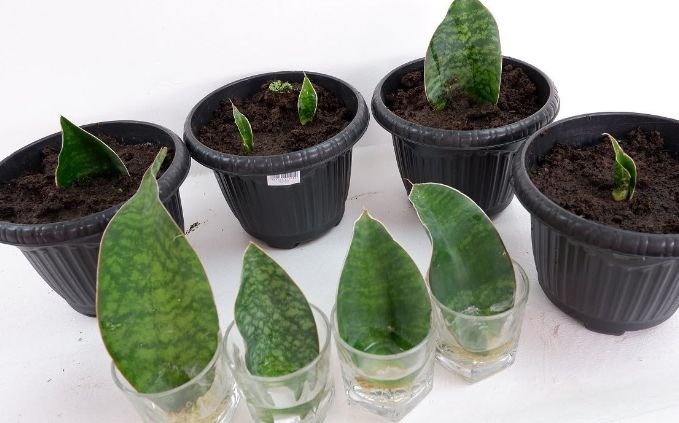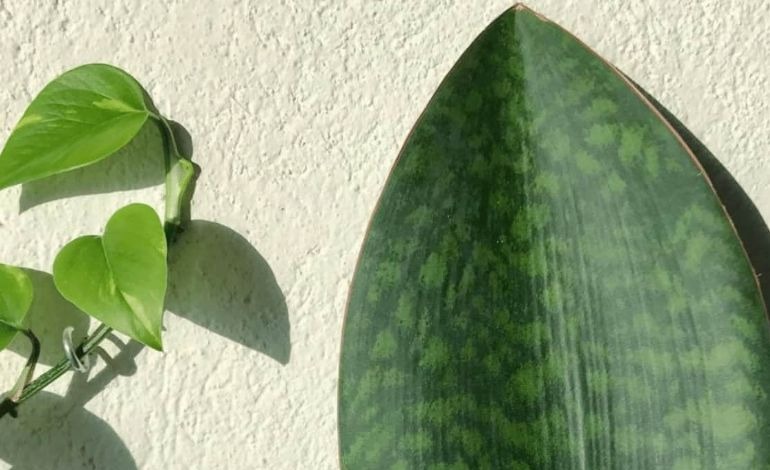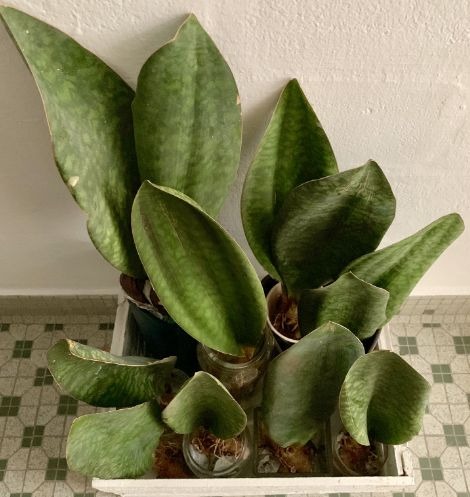Whale Fin Sansevieria - Growing and Care Guide 2023
Written by Ivy
Jan 07 2023

The maintenance of your Whale Fin Sansevieria is identical to that of the others. I'll also show you my experience so far with this plant as we look at some care and propagation advice.
Whale Fin Sansevieria Overview
| Botanical Name | Sansevieria masoniana |
| Common Names | Whale fin plant, Whale fin snake plant, whale tail plant |
| Origin | Congo, Central Africa |
| Family | Agavaceae |
| Plant Type | Perennial succulent plant |
| Full Size | Ranges from 2 feet to 4 feet tall |
| Sun Exposure | Bright, filtered sunlight |
| Soil Type | Light, well-draining succulent soil mix |
| Toxicity | When ingested, it might be harmful to both people and animals. |
Whale Fin Sansevieria Care

This plant requires the usual care for snake plants! But first, allow me to dispel a widespread misconception about Sansevieria.
The best results won't be obtained if you cram this plant into a dim area of your house, despite the fact that it is classified as a low light plant.
Nor does it imply that they REQUIRE dim lighting. It merely indicates that they will TOLERATE dim lighting! If you don't place your plant in good light, it will gradually deteriorate over time.
Sansevieria can, in actuality, withstand moderate amounts of direct sunlight. I had the good fortune to visit Africa, where Sansevieria could be found growing in some full sun and some semi-shaded locations beneath trees.
Light
Whatever you do, by all means, make sure your plant is situated as near to a window as you can. Even a little indoor direct sunlight would be beneficial for these plants.
Windows with an eastern or western exposure are ideal for these plants. However, if the windows on the North side are larger and unobstructed, I do not discount them. However, it is preferable to have some direct sunlight.
The best exposure is from south windows, which will also work. If you reside in an area where the sun is very strong, you might want to slightly filter the sun's rays. Since I live in Ohio, I don't have much to worry about…
Although you can grow a variety of plants indoors, for the best growth and results, place them directly in front of a window.
Just keep in mind that your potting mix will dry out more quickly in brighter light. And that brings us to…
Watering
Always water completely. Yes, these plants must dry out between waterings, but it is always a good idea to thoroughly water your plants for a strong root system.
Any plant qualifies.
To ensure that water seeps through the drainage hole, thoroughly soak the soil surrounding the entire pot. Never let your whale fin sit in water because this will cause root rot; instead, discard any extra water.
Taking your plant to the sink to water will make this simple.
Take extra care if your plant is growing in a pot with drainage holes that you water in place but that is also a decorative cache pot. Make sure to check the bottom of the cache pot to make sure no extra water has accumulated there.
Remove the extra water if it has.
After watering, wait until the soil is completely dry, or nearly so, and then water it again. Try not to wait too long after the soil has dried out before watering again, though it can tolerate some neglect and lengthy dry periods in between waterings.
The soil where your whale fin grows best dries out relatively quickly in between waterings.
This shouldn't be a problem if your plant is growing in a good environment with adequate lighting, cozy indoor temperatures, and a well-drained potting mix.
I enjoy using my finger to feel the moisture of the soil. Additionally, you can check to see if your pot has significantly lighter by picking it up. The good news is that these plants don't complain and whimper like some other plants because they can withstand droughts very well.
Fertilizing
Despite the fact that these plants don't require much food, I continue to fertilize them with Schultz Cactus fertilizer all through the growing season.
You'll want to use a lower nitrogen fertilizer like Schultz 2-7-7 Cactus Plus. Furthermore, your plant will understand if you skip a few applications during the growing season.
With each watering, this fertilizer will fertilize the plants. Simply follow the instructions on the package.
And keep in mind that poor culture cannot be fixed by fertilization! Use it to help your plant grow in addition to other methods. Making sure you are giving the appropriate light, watering, etc., should be your primary concern. first before thinking about fertilizing.
Soil Mix & Transplanting
Repot your Masoniana plants every two to three years. Nutrient levels in the soil will drop over time. Replanting your whale fin snake plant will improve the soil's nutrition.
Sandalwood or loamy soil with a neutral PH is preferred by snake plants. A well-drained potting mix is necessary for Sansevieria masoniana grown in pots. To aid in draining extra water out, choose a container with drainage holes.
Grooming and Maintenance
Low upkeep is required for snake plant care. Despite needing little maintenance every day, the plant can gather dust.
Once a month, wipe down the enormous leaves with a damp cloth to keep the plants looking clean.
Propagating Masoniana Sansevieria
It might need to be divided if your whale fin snake plant thrives.
Cut off a portion of the roots and leaves to produce additional plants. In new soil, replant them.
Alternatively, if there are enough extra leaves on a plant, you can cut the leaves off at the base. Put the cut leaf's bottom in a cup of water.
Occasionally change the water. You should start to see roots forming off the cut leaf's bottom after about a month or two.
If you want to grow your whale fin snake plant this way, make sure your water has a neutral pH.

Sansevieria Masoniana Pests Or Diseases
Although root rot can result from overwatering, it may not itself be a pest or disease. Sansevieria masoniana is adversely affected by rotting roots.
One of the snake plant's most frequent issues, particularly when it's in a pot, is root rot.
On snake plants with too much moisture or not enough light, some types of mold and fungus can develop. Sansevieria masoniana may also experience issues with mealybugs and spider mites.
Neem oil and water applied to leaves can be used to wipe away insects and prevent others from landing on the leaves.
Whale Fin Sansevieria Plant Size
The enormous leaves of this rhizomatous perennial, which grow to a height of 1-2 feet and a width of 4-5 inches, make it the king of Sansevierias. Slow-growing, the Whale Fin plant. For best plant growth, put it close to a window that faces east or west.
It can spread out to a maximum of 10 inches and grow to a height of 2-4 feet when left outside.
Why My Whale Fin Sansevieria Plant Has Brown Leaf Tips?
If your whale fin snake plant doesn't receive enough moisture through its roots and from the air, the edges of its leaves may turn brown. Check to see if the humidity in the area where your plant is located is appropriate for its needs and water it as directed.
You might also need to think about how much and how often you apply fertilizer. It is possible to burn the foliage of your houseplants by overfeeding, which usually shows up as browning leaf edges.
How to Fix Whale Fin Sansevieria Plant Yellow Leaves
On a Mason's Congo Sansevieria, the edges of the leaves can yellow for a variety of reasons. It's possible that the plant isn't getting enough sunlight, and it's also possible that it's getting too much or too little water.
Yellow leaves must be pruned in order to encourage new growth and prevent degradation from spreading. They might also be disturbing and ugly to look at. With a pair of clean, sharp shears, simply remove the leaves.
Why My Whale Fin Sansevieria Root Rot
The two most typical root rot causes are excessive watering and poor drainage. Prevention is crucial because root rot frequently results in death and is permanent.
Plant your Dracaena in cactus and citrus potting soil and give it a dry environment to grow in. When the top two inches of the soil are completely dry, water the area.

Conclusion
A special variety of snake plant called Sansevieria masoniana is perfect for your collection of potted plants or for use in hot, humid gardens.
These large-leaf plants thrive close to windows with lots of natural light and require little maintenance. Your Sansevieria masoniana will flourish with a little care and bring you years of pleasure.
Frequently Asked Questions
Why Are Whale Fin Plants So Expensive?
They grow slowly, which is why this is the case. They cost what they do because of this.Why is My Snake Plant Dying?
The majority of snake plant issues are caused by overwatering.Are Variegated Whale Fins Rare?
They are rare plants, that is true. They are pricey in part because of this.
How Fast Do Whale Fin Plants Grow?
Yes, their growth is fairly sluggish. Before repotting them, 2 to 3 years may pass.
What is the Rarest Sansevieria?
The rarest Sansevieria variety is the whale fin plant.Latest Updated
- Benefits of Bugleweed - 7 Science-backed Health Benefits
- Bugleweed Dangers & Side Effects - Is It Poisonous?
- How to Plant Evergreen Trees - What You Should Know
- When to Plant Evergreens - Grow Guide for Evergreen Trees
- 12 Wonderful Evergreen Shrubs for Your Garden
- 12 Popular Evergreen Plants with Pictures for Beginners
- When And How To Prune A Lilac Bush Like a Pro
- How to Grow & Care for Lilac Vine (Hardenbergia Violacea)
- Japanese Lilac Tree (Syringa Reticulata) Care & Propagation Guide
- Shumard Oak Pros and Cons - What to Know
Popular Articles
- Winter maintenance of Antirrhinum Majus
- How to Grow Terminalia Mantaly Tree
- How to Grow and Care for Crossostephium Chinense
- How to grow Antirrhinum Majus in spring
- Peristeria Elata (Dove Orchid) Profile: Info & Care Guide
- Underwatered Snake Plant (Sansevieria Trifasciata) - Signs And How To Fix
- How to Care for Brazilian Jasmine Plant (Mandevilla Sanderi)
- How to Grow & Care for Graptopetalum Purple Delight in Summer
- Rosa Chinensis (China Rose): Plant Growing & Care Tips
- How to Care for Baby Sun Rose (Aptenia Cordifolia)